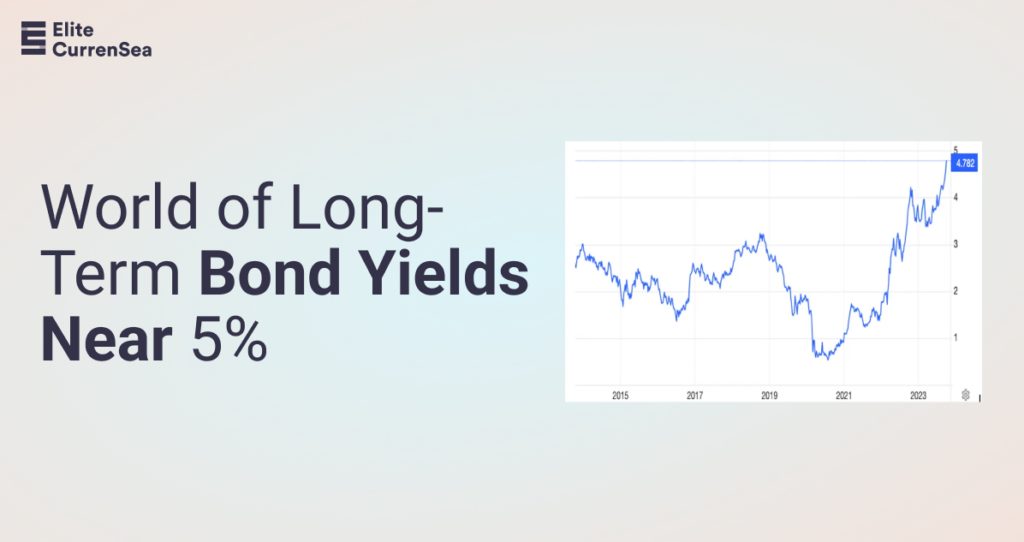Navigating the Tides: The Resurgence of Rising Interest Rates

In recent times, the financial discourse has been abuzz with the notions of rising interest rates, heralding a shift from the prolonged era of low rates. This narrative has permeated through various market dynamics, stirring both opportunities and concerns among investors.
Here we delves into the intricacies of this financial paradigm shift, elucidating its implications on bond yields, market behaviors, and broader economic spheres, while also proffering actionable insights for navigating the evolving market landscapes.
Unraveling the Rise in Rates
The narrative of rising interest rates has transcended from mere financial jargons into a tangible market phenomenon. A notable indicator is the significant ascent of bond yields, particularly in the United States, where the ten-year Treasury yield has soared past the 4% mark, a threshold unbreached since 2008. This upward trajectory reached a pinnacle on October 3rd, registering a 16-year high of 4.8%—a stark deviation from the erstwhile low-rate regime.
The Federal Reserve’s Role and Market Reactions
The trajectory of long-term rates is invariably intertwined with the Federal Reserve’s policy maneuvers. Two pivotal factors underpin this correlation:
- Policy Expectations: The market’s anticipation of future rate adjustments by the Fed.
- Term Premium: A compensatory mechanism for investors against unforeseen adversities like interest rate spikes, government defaults, or inflation surges.
Both elements have evidently contributed to the escalating yields, signaling a metamorphosis in policy expectations and risk assessments.
The Ripple Effect on Global Markets
The reverberations of rising rates have transcended beyond the American financial enclave:
- The augmentation of borrowing costs, rendering mortgages less attainable and new ventures more expensive.
- The diversion of investments from equities to low-risk securities, buoyed by higher interest yields.
- The global spillover effect, epitomized by the dollar’s ascension, propelling other central banks towards a tightening stance to curb inflationary pressures from costlier imports.
The European and Asian Financial Fronts
In Europe, particularly in Italy, the burgeoning cost of debt has reignited concerns over the sustainability of public finances. Concurrently, Japan’s recourse to artificial yield capping—exemplified by massive bond purchases—reflects a palpable apprehension towards the rising rates narrative.
Actionable Insights
Amidst the unfolding financial dynamics, prudence and strategic foresight are paramount. Here are some actionable suggestions:
- Equity Sectors:
- Buy: Consider allocating assets in sectors less susceptible to interest rate fluctuations, such as utilities or consumer staples.
- Sell: Reassess holdings in sectors highly sensitive to interest rate shifts, like real estate or financials, which might face headwinds in a high-rate environment.
- Currency Pairs:
- The typically favorable milieu for the domestic currency in a rising yield scenario propels pairs like USD/JPY or USD/EUR.
- Buy: Engage in long positions in USD/JPY, USD/EUR as a stronger dollar, buoyed by higher yields, could drive these pairs upwards.
- Sell: Alternatively, pairs like EUR/USD or JPY/USD may face depreciation pressures, making them potential candidates for short positions.
- Monitor: Keep a close eye on central bank policies globally as they could influence currency pair dynamics.
- Commodity Markets:
- Higher yields can exert pressure on commodities, as a stronger dollar typically makes commodities priced in USD more expensive.
- Buy: Consider long positions in precious metals like gold as a hedge against market volatility.
- Sell: Evaluate short positions in commodities sensitive to economic growth such as copper, which might be adversely affected by higher borrowing costs.
- Bond Markets:
- In a rising rate environment, bond prices generally decline. However, different types of bonds react differently to interest rate changes.
- Buy: Look towards short-term bonds which are less sensitive to interest rate changes compared to their long-term counterparts.
- Sell: Reevaluate holdings in long-term bonds, as they are likely to be more adversely affected by rising rates.
- Diversify: Consider diversifying into inflation-protected securities or floating rate bonds as a hedge against rising rates.
Concluding Remarks
As the financial horizons continue to evolve, the discourse around rising rates is poised to be a recurrent theme.
While the journey ahead harbors uncertainties, a judicious assessment of market dynamics and a resilient investment strategy are indispensable for navigating through the financial tides.
Safe Trading,
Team of Elite CurrenSea Team







Leave a Reply